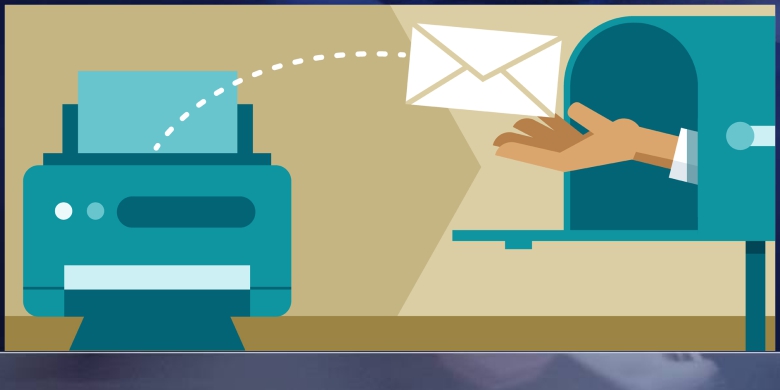Our Latest Blogs
Our Solutions News Blog was envisioned to gather and share information from the very best to help you and your business to become more effective.
Our Solutions News Blog was envisioned to gather and share information from the very best to help you and your business to become more effective.

A lot of people are confused by the many ways print is viewed compared with online media. People often think they accomplish the same things, but the reality is these two distinctive products can serve very different purposes. Here's what makes us all think the same about print.
1. Print is For Keeps... read on »
2. Print is Portable... read on »
3. Print Drives a Higher ROI... read on »
4. Print is Beautiful... read on »
5. Print Plays Well... read on »
6. Buyers Seek Print... read on »
7. Print is Credible... read on »
8. Print Puts Them In Control... read on »
9. Print is Personal... read on »
10. Print is Everywhere... read on »
Source: Xerox
Attend the HP Wall Décor course for Your AIBC or IDCEC Core Learning Unit Credit » read on

1. Interior designers do the same thing as interior architects?
A lot of people are confused by the many different job titles there are in the design industry. However, a very common mistake is to think that interior designers and interior architects do the same job. The reality is that these professions can involve many different things which are more often than not, very far apart. Generally speaking, interior design has more to do with the art of the building, while interior architecture is more concerned with the science behind it.
2. Interior design is all about décor
Interior design involves much more than just a good knowledge of décor. As we’ve mentioned in our previous article on the topic, the practice of interior architecture requires designers to consider pretty much everything to do with the building of an interior space that will affect human habitation, including materials, finishes, electrical requirements, plumbing, lighting, ventilation, ergonomics, and intelligent use of space. Interior designers with training in interior architecture will usually be present at, and have an important say during all stages of the construction process, from the initial plans right through to the finishing touches.
3. Hiring an interior designer is very costly
Depending on the scale of the project, the budget and the time frame you have in mind for finishing it, the price of hiring a professional interior designer can vary dramatically. In most cases, interior designers charge very reasonable fees and the value you get for your money will be worth paying for. If you’re not sure how much your interior design project would cost, you can simply enquire and decide if you are ready to pay for it.
4. Interior designers only work with very expensive materials
As every other professional, interior designers can work with both expensive and cheap materials and products. More importantly, they will work within the limits of the budget and requirements you give them as their client. You have to remember that the price of materials is not always crucial to getting the end result you desire. If you’re working with an experienced interior designer, they should be able to recommend you the best quality products at the most reasonable price there is.
5. You don’t need to have AN education to become an interior designer
There are many people out there that claim that they are interior designers, without having any formal education. However, as explained in some of the other points above, interior design is a very challenging and exciting profession that includes a variety of tasks and requires a great deal of skills and knowledge. The only way you can ensure that you have all these on board when applying for a job, even at an intern level, will be to obtain a formal qualification from a recognised organisation. A career in interior architecture and design can be difficult to get started and an accredited course in the subject will give you a head start by providing you the knowledge, skills, and qualifications you need to succeed.
6. Interior designers make all the decisions for you
Don’t expect that all decisions on an interior design project would be made by the designer you have hired. He or she will have a lot of recommendations on the way ideas can be implemented, but the final decisions will lie with you.
7. Interior designers can’t work with existing structures, materials and objects – they always want to throw everything old away
The truth is that interior designers always work towards achieving the goals in an interior design plan. If this plan involves the stripping of a building to its bare bones they would definitely need to throw everything old away. This is not always necessary and you can keep as much of your old stuff in your new house or space as you want.
8. “I don’t need an interior designer – I can do it on my own”
As we outlined earlier in the article, interior design is a very complex job. You can try and do some of its components on your own, but unless you have the training and understanding of interior design concepts, we think you shouldn’t start any project, small or big without a professional eye. There are so many examples of terrible design decisions that show that it is not worth risking your dream project, if you can leave it to the professionals. At the end of the day, you wouldn’t operate on somebody if you’re weren’t a doctor, right?
9. Interior designers always want to be trendy
Interior designers always strive to be aware of the new trends in their profession. However, they wouldn’t force you to do something on your project if you don’t like it or you think it doesn’t suit your needs. Trends are interesting to follow, but they are not something every interior designer tries to implement in their work.
10. Interior designers don’t need a plan for their projects
Interior designers can’t work without a plan for their project. They need to think about every single detail and plan in appropriate time for it. A good plan means that as a customer you will get an idea on the cost involved as well as the deadline for completion of each stage. Planning is a crucial part of the job of the interior designer.
11. Interior design doesn’t require a lot of time
Interior design projects can take a lot of time and this usually happens because the whole process requires the attention, skills and knowledge of the many other specialists who work with the interior designer. The designer needs to be able to speak everyone else’s language – from the plumber to the conservation officer, to be able to make the project plan work. This doesn’t mean that all interior design projects take years to complete – a complex, but very well organised job on a residential property, for example, can take around five months from start to finish.
12. Interior designers don’t need to work towards a budget
A good plan always comes with a clear idea of the budget the client has for it. There’s no such thing as “open budget” – interior designers should know what is affordable and what is not, because this can help them make some very important decisions. Give your interior designer a budget to work with and leave the magic touch to them!
Source: Id! Blog Written By: The IDI Team
Last year was all about taking risks in graphic design. But most of the graphic design trends we predicted last year have become mainstream. Like incorporating a whole new world of colour, and breathing life into print with a rainbow of metallic huges. Click HERE to download the metallic ink design guide.
What are the BIGGEST graphic design trends of 2019 that you should be following?
That’s what this design guide will tell you. For an in-depth guide to the biggest graphic design trends in 2019, check out the full article and infographic HERE.
The blog post contains a ton of examples for each trend, as well as templates that you can use to stay on top of the trends. In the video above, we introduce you to the 8 graphic design trends that we predict are going to take over in 2019. We’ve included examples from some of the biggest brands in tech right now, including Apple, Spotify, MailChimp, Facebook and more.
If you want your branding to be ahead of the curve, try incorporating some of these graphic design trends into your proposals, marketing materials, packaging and internal communications.
Source: Venngage / Written By: Ryan McCready
The strategic use of psychology in direct mail can drive amazing results. Did you know that our brain is doing most of its work outside of our consciousness? If we are able to create a good direct mail psychology strategy that enables us to tap into subconscious decisions, we can generate a greater response from prospects and customers.
How Can This Work?
1. Emotional Triggers
Both men and women need emotional engagement for direct mail to work. This requires the use of both good emotional copy and imagery. Segmentation can really help you target the right people with the right emotional copy and images.
2. Overload
When there is too much clutter of messages, either copy or images, the brain cannot process it. Make sure that you leave white space and use concise copy so that the brain can easily process your message.
3. Interesting
The brain likes puzzles and humor. Keep them simple for easy understanding. They are effective, with increased engagement.
4. Women and Empathy
If your audience is women, you need to tap into empathy. Women engage with images depicting faces and direct eye contact. Women also respond to group/community activity images and, of course, babies, too. Some women will pay attention to messages that make life easier, celebrate her or allow her to do multiple things.
A complicated mail message will most likely be ignored by the brain. There are ways to simplify your copy and images to capture attention.
How to Capture Attention
Novelty — This is the No. 1 way to capture attention. Our brains are trained to look for something new and cool. A novel message or layout can really help you stand out in the mail box.
Eye Contact — Humans are social beings. Images of people or animals making eye contact with your prospects or customers grab attention and draw them into the mail piece.
When you are able to integrate a multiple sensory experience into your mail piece, you create a richer and deeper engagement with your audience.
How to use the senses:
As you can see, the brain is powerful and is very good at ignoring messages. Taking the time to consider all of these psychological factors can really help you drive your response rates up. As always, focusing your messaging with targeted segments to really reach the right people with the right message will increase the success of your mail campaigns. Are you ready to get started?
Source: Target Marketing / Written By: Summer Gould
It’s an age-old debate: direct mail versus email marketing.
Supporters of digital media will say why drain your marketing budget on direct mail campaigns that nobody reads when you can contact your customers using the channels they prefer — television, social media, and mobile?
However, the latest data makes a strong case for printed direct mail. Sure, social media and mobile marketing are on the rise. But that doesn’t mean that customers aren’t responding to direct mail or that this channel is losing its effectiveness. That’s just plain false.
The reality is, direct mail remains a critical part of the mix. So the next time someone tries to tell you direct mail is dead, remember:

1. Direct mail doesn’t require opt-in
Unlike email and text messaging, you don’t have to get a recipient’s permission to send them direct mail. This means, even if a customer doesn’t subscribe or unsubscribes from your email list, you can still get in touch with them. (Which is why it’s always a good idea to get physical addresses from those on your email lists!)
2. Direct mail never stays in a spam filter
"Yes, your message may be picked by someone else," notes Roger Buck, former director of marketing and product development at The Flesh Company. "But the chances are small - and direct mail never has a virus."
3. Direct mail stays effective longer than you think
Direct mail is a bit like a note on the refrigerator door. "We sometimes hear from customers that our mail stays on their desk for weeks," says Andre Palko, president of Technifold USA. "They may not immediately take action, but our brand lingers until they are ready to contact us. An e-mail does not last as well - and is far less striking. "
4. It’s still effective when the target recipient has moved on
“If you send an email to someone who’s no longer at a particular company, it bounces. If you send a postcard, the new person in that job sees it — and you’ve just introduced yourself as a vendor,” says Palko.
5. With direct mail you do not have to fight to get attention
E-mail is effective, but also overwhelming. In 2014, The Radicati Group concluded that the average business customer sends or receives 121 emails per day. In 2018 there are probably 141 in all likelihood.
Larry Bradley, owner of Proforma Sunbelt Graphics, writes: "The overwhelming deluge of e-mail in the office is a solid hurdle for e-mail marketers. It is difficult to distinguish the mess from the real mails, so that a large part of business e-mails is not read at all. By contrast, companies receive much less marketing by mail than ten years ago - a unique advantage for direct mail."
6. Certain offers just won’t get traction by email
There’s a reason businesses are more likely to get lending offers in the mail than they are by email. B2B decision-makers trust direct mail more than email, especially for high value products and services. Mailers can also include a wide variety of trust-building content not possible (or reasonable) to include in email. Yes, you can provide links. But with direct mail, you get that content in front of them in a tangible way right out of the gate.
7. Direct mail can reach high-level decision-makers
There are only so many things you can do to make email look more important. But beyond writing a compelling subject line, most of them look hokey. Direct mail offers options like kits, dimensional mail, and unique packaging options that, by their nature, get past the gatekeepers. (Palko has used everything from metallic envelopes, lunch bags, packing list pouches and prescription bottles to mail letters. “They are not only fun, but they get opened!” he says.) While these mailings may have higher price tags, they can also get near 100% open rates. When you’re trying to reach the C-Suite, that’s worth a lot..
8. Direct mail drives social media and online marketing
Many people believe you don’t need direct mail when you have social media and mobile marketing. What they’re overlooking is how social media and mobile marketing relationships get captured in the first place. Very often, it’s through print. Saying that you only need social and mobile is akin to saying that when you buy a house you only need the upper stories and not the foundation. Without print, getting social and mobile engagements is much more difficult.
Don’t let digital marketers get away with stealing your customers based on false contrasts. Open the discussion about the benefits of direct mail versus email—and when to use each. Be proactive and let direct mail showcase what you can do.
Source: Xerox / Written By: Heidi Tolliver-Walker

1. Interior designers do the same thing as interior architects?
A lot of people are confused by the many different job titles there are in the design industry. However, a very common mistake is to think that interior designers and interior architects do the same job. The reality is that these professions can involve many different things which are more often than not, very far apart. Generally speaking, interior design has more to do with the art of the building, while interior architecture is more concerned with the science behind it.
2. Interior design is all about décor
Interior design involves much more than just a good knowledge of décor. As we’ve mentioned in our previous article on the topic, the practice of interior architecture requires designers to consider pretty much everything to do with the building of an interior space that will affect human habitation, including materials, finishes, electrical requirements, plumbing, lighting, ventilation, ergonomics, and intelligent use of space. Interior designers with training in interior architecture will usually be present at, and have an important say during all stages of the construction process, from the initial plans right through to the finishing touches.
3. Hiring an interior designer is very costly
Depending on the scale of the project, the budget and the time frame you have in mind for finishing it, the price of hiring a professional interior designer can vary dramatically. In most cases, interior designers charge very reasonable fees and the value you get for your money will be worth paying for. If you’re not sure how much your interior design project would cost, you can simply enquire and decide if you are ready to pay for it.
4. Interior designers only work with very expensive materials
As every other professional, interior designers can work with both expensive and cheap materials and products. More importantly, they will work within the limits of the budget and requirements you give them as their client. You have to remember that the price of materials is not always crucial to getting the end result you desire. If you’re working with an experienced interior designer, they should be able to recommend you the best quality products at the most reasonable price there is.
5. You don’t need to have AN education to become an interior designer
There are many people out there that claim that they are interior designers, without having any formal education. However, as explained in some of the other points above, interior design is a very challenging and exciting profession that includes a variety of tasks and requires a great deal of skills and knowledge. The only way you can ensure that you have all these on board when applying for a job, even at an intern level, will be to obtain a formal qualification from a recognised organisation. A career in interior architecture and design can be difficult to get started and an accredited course in the subject will give you a head start by providing you the knowledge, skills, and qualifications you need to succeed.
6. Interior designers make all the decisions for you
Don’t expect that all decisions on an interior design project would be made by the designer you have hired. He or she will have a lot of recommendations on the way ideas can be implemented, but the final decisions will lie with you.
7. Interior designers can’t work with existing structures, materials and objects – they always want to throw everything old away
The truth is that interior designers always work towards achieving the goals in an interior design plan. If this plan involves the stripping of a building to its bare bones they would definitely need to throw everything old away. This is not always necessary and you can keep as much of your old stuff in your new house or space as you want.
8. “I don’t need an interior designer – I can do it on my own”
As we outlined earlier in the article, interior design is a very complex job. You can try and do some of its components on your own, but unless you have the training and understanding of interior design concepts, we think you shouldn’t start any project, small or big without a professional eye. There are so many examples of terrible design decisions that show that it is not worth risking your dream project, if you can leave it to the professionals. At the end of the day, you wouldn’t operate on somebody if you’re weren’t a doctor, right?
9. Interior designers always want to be trendy
Interior designers always strive to be aware of the new trends in their profession. However, they wouldn’t force you to do something on your project if you don’t like it or you think it doesn’t suit your needs. Trends are interesting to follow, but they are not something every interior designer tries to implement in their work.
10. Interior designers don’t need a plan for their projects
Interior designers can’t work without a plan for their project. They need to think about every single detail and plan in appropriate time for it. A good plan means that as a customer you will get an idea on the cost involved as well as the deadline for completion of each stage. Planning is a crucial part of the job of the interior designer.
11. Interior design doesn’t require a lot of time
Interior design projects can take a lot of time and this usually happens because the whole process requires the attention, skills and knowledge of the many other specialists who work with the interior designer. The designer needs to be able to speak everyone else’s language – from the plumber to the conservation officer, to be able to make the project plan work. This doesn’t mean that all interior design projects take years to complete – a complex, but very well organised job on a residential property, for example, can take around five months from start to finish.
12. Interior designers don’t need to work towards a budget
A good plan always comes with a clear idea of the budget the client has for it. There’s no such thing as “open budget” – interior designers should know what is affordable and what is not, because this can help them make some very important decisions. Give your interior designer a budget to work with and leave the magic touch to them!
Source: Id! Blog Written By: The IDI Team
So, what is interior architecture? There has been a debate raging for some time around the terms architecture, interior architecture, interior design, and interior decoration. The discussion centres on the blurring of the lines that define the role and responsibilities of each profession: where does the interior design of a space end and architecture begin, and vice versa?

So, what is interior architecture?
There have been a number of factors over the last few decades that have increased the ambiguity of these titles, including the improvement of interior design education. This has in turn increased the scope of the profession and led many interior designers to becoming more involved with architectural and technical aspects of interior design, and less with the decorative, soft furnishings side.
As a result, many interior design degree courses have been renamed as interior architecture degrees to more accurately reflect what they cover. Courses like this have also shot up in popularity, producing a growing number of architecturally savvy designers, and in turn making it more difficult to differentiate between architecture and interior design.
So what is interior architecture, and perhaps just as importantly, how does it differ from architecture, interior design and interior decoration?
Click HERE to find our more about the differing roles and responsibilities of all of these professions.
Source: Id! Blog Written By: The IDI Team
Marketing is an ever evolving combination of art and science, and today marketing's role is growing in importance. The challenges of producing tangible growth and ROI are two trends that will continue to grow as the business climate becomes more competitive, and the opportunities more fragmented.
Market fragmentation is creating a new frontier in terms of techniques, strategies and reach. As niches become more focused, the concept of a “market-of-one” is becoming the new reality. We have to create a “unique” experience for each prospect to drive them to convert, build trust, and finally act.

Focusing On Customer Experience
These trends deserve your attention as you address the complexities and challenges of marketing in the coming year.
1. The Growing Role of B2B Marketing
This year will see marketing expand beyond its traditional role. Businesses are facing new and unique challenges today, like the shortage of talent, commoditization and increasing competition to name just a few. These are enterprise-wide challenges that will require cross-departmental collaboration to solve, and marketing is in the perfect position to take the lead.
Watch for greater alignment between marketing and HR, sales, and operations. Everything from addressing employer branding strategies to recruit talent, to business development will be calling on marketing to increase value and visibility.
2. Balancing The “Customer Experience”
Probably the biggest trend to watch in the coming year will be the task of focusing on customer experience while still driving growth. Marketers have been focusing on “customer-centric” methods, basing their approach on the lifetime value of a prospect.
This year, the focus will be on adding “customer-focused” techniques of providing relevant experiences across all touch points, to deliver what customers most value. Balancing these two approaches can deliver a more personalized approach that will generate higher revenue, while building stronger brand loyalty.
3. Executive Branding: Thought Leadership
In the past few years the focus of branding (thanks to the Internet, mobile, and social media) has shifted to the individual – both in terms of the customer, as well as the “voice” of the business.
As a result traditional branding and marketing efforts aren't enough. Especially when it comes to B2B marketing. Today, executive branding, or developing thought leadership is growing. Buyers want to know the “why” behind the business and put a face to the operation to build trust. In order to really stand out, executive branding will be the fastest growing trend in B2B marketing in the coming years.
4. Formats, Channels and Mix
As marketing refocuses on thought leadership, the need will arise to refine content and marketing mix as well. As more channels and delivery platforms become available, marketing teams will need to better leverage a broader mix of marketing choices and formats.
For example, video both pre-recorded and live is becoming much more prominent as is live streaming of events. Diversification of content delivery formats includes podcasts, interactive assessments (as in the managed print field) and mobile friendly content. Marketing firms will also see a shift from Twitter and LinkedIn to more non-traditional B2B formats like Facebook and Instagram. Along with this shift will come the reliance on paid opportunities to boost distribution away from organic-only approaches.
5. Artificial Intelligence/ Machine Learning
DRIP Marketing has grown in the past few years, and the "automation" trend will continue as the integration of artificial and machine learning in B2B marketing grows in importance.
According to Forrester Research, “AI will provide business users with access to information and insights before they're available.” By using cognitive interfaces, complex systems and advanced analytics combined with machine learning technology, business decisions in e-commerce, marketing, product management and other areas will be able to happen almost in real time.
6. Experiential Marketing
Imagine being able to give your customers and prospects the opportunity to experience your brand in “real life” or the virtual world. This trend will grow in the coming years, especially in the B2B space. As virtual reality begins to take a greater hold, it will be possible to immerse prospects or customers from anywhere in the world.
A great example in the B2C space is the growing use of virtual reality in luxury home sales. Prospects are able to take an "immersive" tour of properties that have not yet been built. When it comes to B2B, educate yourself about the latest experiential strategies and techniques and how you can integrate them into your marketing strategy so users can “touch," “taste” or “feel” your brand. Internally, experiential marketing is a great opportunity to engage, educate and energize employees.
These are 6 trends to be aware of in the coming year. As marketing continues to become more personalized, the techniques, strategies and channels will continue to evolve. Staying ahead of the trends and technologies that are changing our business will be the key to success moving forward!
Source: Adobe Hubspot Blueleadz Written By: Rob Steffen
In a survey conducted by ResearchNow for Adobe, 76 percent of marketers believe marketing has changed more in the last two years than in the previous 50....
Convenience Is the New Currency
Time and money have always been directly correlated, and for the last several years, consumers have been short on both. Even though we’ve made quite a comeback from the dark days of the economic collapse in late 2008, the Great Recession is still fresh on everyone’s mind.
As a reaction to the substandard economy that wrapped up the first decade of the new millennium, buyers have become obsessed with finding unsurpassed value, with competitive sellers bending over backward to come up with new ways to draw in potential customers. Bottom-line pricing, impeccable service, and personalized experiences have all become crucial to staying competitive in the post-recession marketplace, but another customer demand has risen through the ranks, forcing companies to rethink the way they market their products and services.
That demand can be summed up in a single word: CONVENIENCE
Click HERE to Read the Full Article »
Source: Adobe Digital Marketing